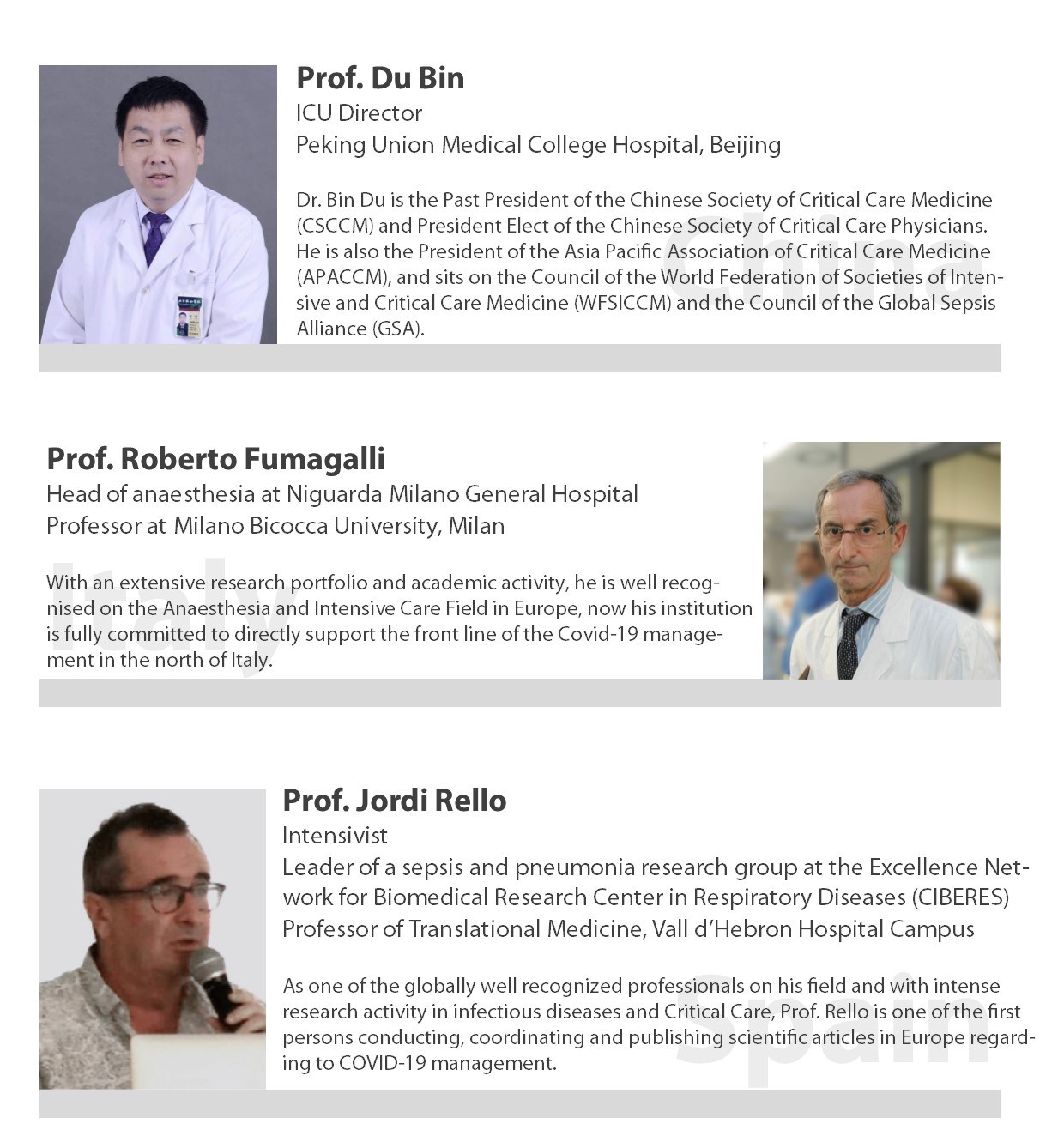
Q: Starting from the patient admission to the hospital, what is your rule for ventilation? Do you start from HFNC, CPAP, NIV or go directly to intubation and invasive ventilation when the conventional oxygen therapy fails?
A: The use of HFNC as well as NIV is very popular among our patients. At the initial stage we didn’t have enough devices, so physicians would grab whatever they have in hand, either face mask, HFNC or NIV, to put them on their patients.
However, the current strategy to manage hypoxic patients with COVID -19 looks like this: for those with mild hypoxemia we try traditional/conventional oxygen therapy and then HFNC or NIV will be used. According to the discretion of treating physicians, this is not sequential, and the trials are made by themselves. If the patient fails to be ventilated on NIV showing either refractory hypoxemia, unresolved respiratory distress or high driving effort suggested by high tidal volume, we consider endotracheal intubation.
Q: Regarding the right NIV management (like CPAP before intubation) and based on my experience CPAP is good but HFNC would be more helpful to patients with high percentage of failure. Do you agree that it is the right approach to start with CPAP and continue with it even after intubation?
A: Well, in terms of non-invasive mechanical ventilation mode, I would say CPAP is seldom used than BIPAP.
Q: Do you have any idea of age or comorbidities that exclude patients from mechanical ventilation support because it is futile? I mean, those patients that will die in nearly 100% of the cases. In your experience which would be the cutting age, and which are the most common comorbidities associated to mechanical ventilation support failure?
A: It is a tough question for me to answer.
Anyway, according to my understanding, the mean age of non-survivors is over 70. Even not only age, but also lifestyle has a strong influence on survival rate. Anyhow, in our usual practice, cardiopulmonary reserve makes more sense towards decision making regarding ICU patient admissions.
However, some comorbidities require more attention. According to my knowledge, hypertension is a risk factor towards critically illness and increased mortality. According to our data (170 non-survivors), 50% of them had a history of hypertension. Although we currently don’t know any other data, you can tell the percentage of hypertension is very high, much higher than the other patients who did survive, so I think hypertension is an independent risk factor.
In addition, pregnancy is not a risk factor, unlike influenza pneumonia. What we observed is that if a pregnant woman has influenza pneumonia, she can get very severely ill and very hard to ventilate. But it is not what we observed with COVID-19. I have seen quite a few pregnant women and they have been doing quite well.
Q(comment): I’m quite surprised about hypertension.
A: Some of my colleagues believe there is a correlation or relationship between COVID-19 and ACE II receptors. I am not sure about that, but we are discussing about the possibilities.
Q: Did you use severity scores to classify patients, or their triage was based on parameters like RR, hypoxemia, etc?
A: As far as I can tell, we don’t use severity scores, neither pneumonia, CURB-65, APACHE II, nor SAPS, neither SOFA. I think the major indicator to identify high risk patients are mainly respiratory parameters like SpO2 and RR as well as presence or absence of respiratory distress. In addition to that, I would rather consider lymphocytopenia as another indicator. Also based on a recent Chinese publication delivered by our colleagues in Wuhan, they identified that hypersensitive troponin I is another indicator to identify potential survivors and non-survivors at the very beginning.
Q: What about other complications, like encephalitis, myocarditis?
A: Personally, I have never encountered any single case of encephalitis, but I do believe the virus may invade the heart directly. I just mentioned biomarkers of cardiac injury and I would say that more than 50% of patients admitted to ICU have elevated hypersensitive troponin I level.
Anyhow, even with elevated level of troponin I, we didn’t observe evidence of any classical manifestations of a virus provoked myocarditis, such as cardiogenic shock or ventricular arrhythmia; it is, definitely, uncommon.
Q: In my hospital, during the first 10 days, we put ARDS 2 patients on VA ECMO and, based on biopsy, both were also confirmed with myocarditis. This is definitely different from your experience, maybe because the population is different?
A: No, not really. Some of the patients, even with decreased biomarker levels for cardiac injury, will eventually develop cardiogenic shock. Some of them even require VA ECMO or vasoactive agents.
Q: What about the potential use of nitric oxide for hypoxemia?
A: The use of Inhaled nitric oxide is not approved yet in China, so we do not have any single case.
Q: What about Italy?
A1: We have a couple of cases, but I don’t have enough experience to say if the good response is related to one single patient or the mechanism works well. Probably, the NO improves the mismatch between the ventilation and oxygenation, but I am not sure about it.
A2: We used it in two cases, one is good, and the other is not.
Q: Was it associated with secondary pulmonary hypertension?
A2: No, in this patient we do not use Swan-Ganz catheter. Thus, I cannot tell if it improves it or not. It works for oxygenation for sure, but in the second patient it did not work, so we don’t use it anymore.
Let’s say, the key point to us is prone position: half of the patients improved, half not. Basically, the younger ones responded to pronation, the older ones did not.
Q: Yes, totally agree. Do you prone your patients in China?
A: Yes, we do. We also observed the response rate in terms of the arterial oxygenation: about 70%-80% of the patients remain with severe hypoxemia when we prone them. In addition, we implemented lung recruitment manoeuvres.
Q: How long did it take for your patients to get some improvements, let’s say, to reach spontaneous breathing trial?
A: For survivors after MV, usually, the length of mechanical ventilation was 10-14 days, although I did see a few cases with only 3 days and some other with 3 weeks. But overall, 2 weeks.
Q: Did you tracheostomize your patients?
A: It depends on the attending physician. I personally will not do early tracheostomy.
For patients with only COVID-19 pneumonia, even though the patient is put on mechanical ventilation for 3 weeks, I will still wait. But some of my colleagues prefer performing an early tracheostomy.
Q: Do you think that with early tracheostomy, it would be easier to decrease the sedation? One of my points is that, keeping the patients on intubation requires more sedation, therefore I just followed the idea that, using an earlier tracheostomy, I could reduce the level of sedation.
A: I understand your point, however, when we talk about severe hypoxemia, here in Wuhan it is very common to see patients deeply sedated, even paralyzed. This is just because any spontaneous breathing will bring negative effects on oxygenation and the respiratory pattern of the patient and it will have negative effect on patient-ventilation discrepancy. So, it all depends on the situation of the patient: if oxygenation is significantly improved, we reduce the sedatives and then, we do not perform tracheostomies, let them wake up and try to do some SBT.
But I do understand different opinions, like yours and some of my colleagues.
Q: How do you proceed with the patient weaning? I understand that you would find very weak patients after 14 days of ventilation. Did your patients show significant muscle weakness?
A: So far, the patients I have seen do not suffer from obvious muscle weakness. Whenever we think the patient is ready to wean we use pressure support of 7 cm of H2O, instead of T-piece, because we do believe that the usage of this piece may lead to virus transmission either to the healthcare professionals or the neighbouring patients. So, we use PS of 7 and, if they pass the test, we consider extubation.
So, the muscle weakness is not a big issue right now to us.
Q: What is your consideration of feeding?
A: Practice variation between enteral feeding or parental feeding is very high. I personally prefer enteral feeding whenever it is possible/tolerated.
Q: What about invasive pulmonary aspergillosis, which has been reported in patients with influenza?
A: My personal belief is that patients with COVID-19 are at the same risk of invasive pulmonary aspergillosis as patients with influenza pneumonia. I do believe they share the same mechanism.
Q: Did you observe co-infection with influenza in your patients?
A: It is very difficult to say: influenza pneumonia was also present, but co-infection with influenza virus was not common. It is also important to mention that not all patients were tested for influenza virus. Only a minority of patients have been tested for both influenza and COVID-19 and I don’t believe co-infection was present in the majority of them.
I know some of the patients have been tested positive to influenza B but I have not seen them myself.
A1: Among our patients, some have been found to have CMV or Epstein-Barr virus infection, around 20% to 25% of them.
Q: These results were confirmed from blood samples or from other specimens?
A1: Blood and pulmonary samples (bronchoalveolar lavage). We try to start the treatment, but we have a very short experience, only 10 days.
Q: Which role plays steroids in acute patients? Are they useful or not? And what is the timing?
A: The use of steroids is very common in China. Corticosteroids are used in 20% of patients with COVID-19 including mild and severe cases and moreover in 60% of patients with severe symptoms.
The use of steroids is controversial from the Chinese experts’ point of view: some doctors prefer corticosteroids and would consider escalating the dose for those patients with signs or symptoms of critical deterioration. The majority of members of this group are pulmonary physicians. However, others have quite different opinions and they believe corticosteroids bring more harm than benefits. Currently, we have no solid data to support either side.
My personal perspective is that corticosteroids may be harmful, and long-term use of corticosteroids brings more complications. Anyhow I am not quite sure about the short-term effects (3-5 days).
Q: We have read that CT scans are widely performed for diagnosis of patients in China. What about the use of ultrasounds for diagnosis?
A: Lung ultrasound and CT scan were widely used, especially these days. Ultrasound devices were not available at the very beginning, but currently they are commonly used by most medical rescue teams for lung and heart, like TTE.
Q: Which are the most important differences in management between COVID-19 and pandemic influenza?
A: In terms of the mechanical ventilation and hypoxemia, I don’t think there is much difference. The only difference I observed is that some of the patients tolerate hypoxemia quite well in terms of the RR, as they don’t show any sign of respiratory distress. However, when you measure their pulse oximetry, the reading may be as low as 80% or even 70%. So, some patients tolerate hypoxemia very well, but I don’t know why.
Also in Wuhan, some invasively ventilated patients eventually developed refractory hypercapnia with PaCO2 higher than 100 mmHg or even 150 mmHg. I believe it is mainly related to the dead space ventilation, although I can’t tell the end line mechanism. Even with the ventilation set up to 50L/min, the PaCO2 was still high, so it is very common for us to have patients whose PaCO2 is as high as 80 mmHg or 90 mmHg.
We believe this is a slow progression, because the pH value is OK (some of the patients even have normal pH) and in those cases it is very difficult for us to manipulate ventilator settings as we try to increase the RR as much as possible, we try to decrease the PEEP to sacrifice the arterial oxygen in order to increase the tidal volume and also, we try prone them to see if there is any decrease in PaCO2. But there are still some patients not showing a very good response.
A2: It is not really uncommon for emergency workers to find patients at home which oxygen saturation is below 90%. We see patients severely desaturated but not really feeling breathing so difficult and no hemodynamic compensation. Certainly, some of them may have severe hypoxemia with these characteristics, but I don’t know why.
A1: Yes, I confirm that many patients have low saturations without showing symptoms. We found patients severely desaturated with secondary organ failure (particularly brain and heart) due to hypoxemia. It is a good point: don’t be tricked by symptoms.
Q: Based on your experience, do you have any specific advice to Western doctors to treat COVID-19?
A: My personal advice to Intensive Care colleagues might include, as I said before, don’t be fooled by your patients’ signs and symptoms:
A: My personal advice to Intensive Care colleagues might include, as I said before, don’t be fooled by your patients’ signs and symptoms:
(1)Always check the SpO2, if you have any doubts.
(2)Try to be more aggressive when starting invasive mechanical ventilation if NIV trials fail, which is very common. Failure rate of NIV is very high, so whenever you try NIV, you must closely monitor your patients for any signs or symptoms of failure.
(3)Whenever the patient is ventilated, either non-invasively or invasively, always pay attention to the driving pressure and the tidal volume. For non-invasively ventilated patients, high tidal volume always means treatment failure. For invasively ventilated patients, high tidal volume or high driving pressure always means more sedation or even paralysis.
(4)Pay more attention to biomarkers for cardiac injury and any signs of viral myocarditis, although ventricular arrhythmia is not common.
(5)Renal failure: I don’t know what happens in European countries, but among our patients, the prevalence of acute kidney injury (AKI) is not less than 30%. Some of them need renal replacement therapy (CRRT) and I do believe the mechanism of acute renal failure is not related to pre-renal factors, so it is not related to renal hypoperfusion. Anyhow I have no evidences of that. There is no evidence of renal involvement in autopsy right now, but I only have data from two autopsies.
(6)No antiviral agent was effective right now (many are still under trial).
Q: I am aware that the focus now is Wuhan, but what is the major difference between Wuhan and other cities in China, like Beijing, Shanghai, and Chengdu?
A: The main difference lies in the mortality rate. The mortality rate in Wuhan, Hubei is much higher than any other city in China. Reasons are as below:
A: My personal advice to Intensive Care colleagues might include, as I said before, don’t be fooled by your patients’ signs and symptoms:
(1)There are many more cases in Wuhan, which means that Wuhan is in shortage of resources including human resources, supplies and devices, and for some hospitals, we even do not even have oxygen supply.
(2)There is always a learning curve. Clinicians in other parts of China learned from the experience of Wuhan, including successes and failures.
(3)Clinicians intubated patients and started IMV earlier in other cities. In Wuhan, if a patient was mechanically ventilated, the FiO2 went as high as 80% or even 100% within the first few days. However, in other cities, clinicians can manage their patients successfully with the FiO2 of 40% to 50%, indicating a more aggressive approach with regards to endotracheal intubation.
(4)I don’t have much knowledge of mutation or genomes as I am not an expert on that field, and I am not quite sure if any mutation of the virus may lead to higher mortality. But my feelings are that this is not the case.
Q: Do you think there is a role for cytokine removal system? If yes, do you have any experience?
A: No, and I am not a fan of extracorporeal removal of the cytokines. It never works on patients with sepsis, right? Some of the hospitals here performed plasma exchange, CRRT or absorption, but for the time being they haven’t shown solid data to convince me.
Q: Yes, some patients show very high IL2, 6, 8, and TNF-alpha1, so that’s why I come to this point.
A: We do not test for IL1, TNF-alpha here in Wuhan, but IL6 was commonly tested. Some of the patents showed very IL6 levels, and the IL6 is associated with disease course. But still I am not convinced by benefits of cytokine removal.
Q: What about the usage of high dose immunoglobulins like in some severe viral infections?
A: My personal interpretation is that, COVID-19 is associated with some degree of immune compromise manifested with lymphocytopenia, however, it may not be associated with deficit or disorders of immuno-response. We suggest collecting enough evidence first to document that immunoglobulins are markedly decreased in these patients, as one of the major mechanism leading to poor outcomes; then the hypothesis could be raised.
These conversations are contributed by all participants, and we would like to credit the questions and anwsers to the collective widsom and communication of them all, hence no specific name revealed in the Q&A.
Latest Articles
CPAP, HFNC, NIV, Coronavirus, COVID-19, #Coronavirusoutbreak, China With The World, Dr. Du Bin, Dr. Roberto Fumagalli, Roberto fumagalli, Jordi Hello, Jordi Rello
Q: Starting from the patient admission to the hospital, what is your rule for ventilation? Do you start from HFNC, CPAP, NIV or go directly to intubation and invasive ventilation when the conventional oxygen therapy fails?



























